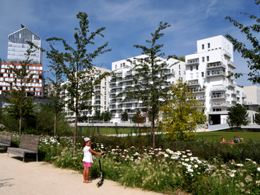COLUMNS
LANDSCAPES

25 September, 2012
Ιle Seguin – Rives de Seine
Urban planning projects of industrial landscapes.
The project Ile Seguin - Rives de Seine is located at the former industrial area of Renault, south of Paris and it is a unique example of urban planning and urban renewal, including a variety of public spaces with special emphasis on natural elements. From 2009 one of the largest urban planning projects in Europe begins, at the old premises of Renault, covering an area of 47 ha. Among them, 37 hectares are in the lowland Billancourt called «le Trapèze», 11,50 hectares on the island Seguin and 4 hectares in Bas-Meudon.

Location of the case study. Google earth. 1/1/2008.
Initially, the proposal aimed to upgrade the region Pont de Sevres and to accommodate 5000 people. The three main design goals were to achieve an appropriate balance between nature and built environment, among social and urban diversity, and between architectural and environmental quality, thereby improving the quality of life for all residents.

Commercial uses are taking place at the ground floor of buildings. September 2011. Photograph by Styliane Philippou.
The area was designed to facilitate travel for the mobility-impaired as well as the partially or fully visually-impaired. In order, to achieve this, the promoter of the Project (SAEM Val de Seine Aménagement) chose to involve the stakeholders throughout the planning process.
The new urban complex built in Rives Billancourt area called «Trapèze», is characterized by a network of green corridors including the park Billancourt, the riverside banks of the Seine and the central part of the island Seguin. Architects, landscape architects, artists, contractors, public and private sectors, worked together, so that the buildings and the green areas to coexist harmoniously. Thus, the area presents a variety of private gardens, parks, green islands and coastal areas along the Seine, giving priority to the development of public spaces (50% of the total area) to biodiversity, to energy efficiency, as well as to reduced traffic impact and to optimum water management. The planting is more organized, minimal and compatible with the overall character of the area dominated by the simplicity and the geometric forms of buildings.


Organized mass planting of grasses framing the public areas. Trapeze-Rives Billancourt. September 2011. Photographs by Katerina Gkoltsiou.
The park Billancourt (7 hectares of land), is the new urban park, of Paris. Water in various forms is the key element of the park..All the rainwater of the area is collected and used to irrigate the lawns.

Park Billancourt. September 2011. Photograph by Katerina Gkoltsiou
The park features a biodiversity of species. Along the paths there are many perennials (anemone, bluebell, white daisies, violets, etc.). The large area of lawn is marked by various trees (oak, black pine, etc.)
The Seguin island (Ile Seguin) is almost artificial and is partly built at the base of the old Renault factory. Seguin Island is divided into three areas: a) the north side of the island will be assigned to uses related to the music. A concert hall 3,000 to 5,000 spectators is going to be built, as well as an auditorium of 600 to 800 seats, shops, etc. b) the southern part of the island will be attributed to a variety of activities aiming at revitalizing the art market in France while facilitating the public's relationship with modern art, c) the center of the island is going to be developed to a large complex equipped with advanced technologies that will offer a varied of programs for broadcasting major sporting events, etc. and to a high standards hotel. While, housing will also be available to artists, students, researchers and entrepreneurs.
According to Michel Desvigne the island will evolve in the coming years as the vegetation will gradually grow. Pioneer species, such as willows, will give a structure to the gardens of the island. Among the linear plantings, the most characteristic species are buddlejas, birches, aspens. The geometrical composition of the gardens is playing with the memory of the place. The gardens are gradually revealed to the visitor.


Ile Seguin. (left) Geometric flower beds within the lawn. (right) Willows frame the seating areas. September 2011. Photographs by Styliane Philippou.
The various urban elements are very characteristic. The seating is an imitation of the old wooden furniture of Renault factory, designed by the architect Inessa Hansch. Special shade structures with expanded metal scaffolding safety nets, replace the shade of mature trees.

Ile Seguin. Typical examples of seats and pergolas. September 2011. Photograph by Styliane Philippou.
Billboards are placed in different parts of the island, allowing visitors to understand the history and geography of the place.

Ile Seguin. Typical information sign. September 2011. Photograph by Katerina Gkoltsiou.
The gates of the park are also particularly marked. A large gate marks the entrance to the Seguin island. Separate entrances are designed for the security and maintenance staff of the gardens.


Ile Seguin. Main entrance. September 2011. Photographs by Katerina Gkoltsiou.
The above examples reflect the strong tendency of man to introduce nature into the city and to organize the landscape according to modern design trends.
Sources
http://www.boulognebillancourt.com/cms/index.php
http://www.ileseguin-rivesdeseine.fr
http://www.aucoeurdelileseguin.fr/en/the-project
Related articles:
- Landscape design for different cultures ( 27 November, 2012 )
- Playgrounds ( 07 November, 2011 )
- New column in greekarchitects by Aikaterini Gkoltsiou ( 06 November, 2011 )
- Green Walls-Vertical Gardens ( 07 December, 2011 )
- Tourist landscapes ( 09 January, 2012 )
- Landscape architecture : hotel renovations ( 09 February, 2012 )
- Mediterranean gardens ( 10 March, 2012 )
- The role of landscape architect in agritourism landscape design ( 12 May, 2012 )
- ΤΑΤΟϊ: Α complete proposal for the protection and enhancement of the former Royal Estate. ( 25 October, 2012 )
- Recognising the dimension of time in the landscape ( 28 February, 2014 )










